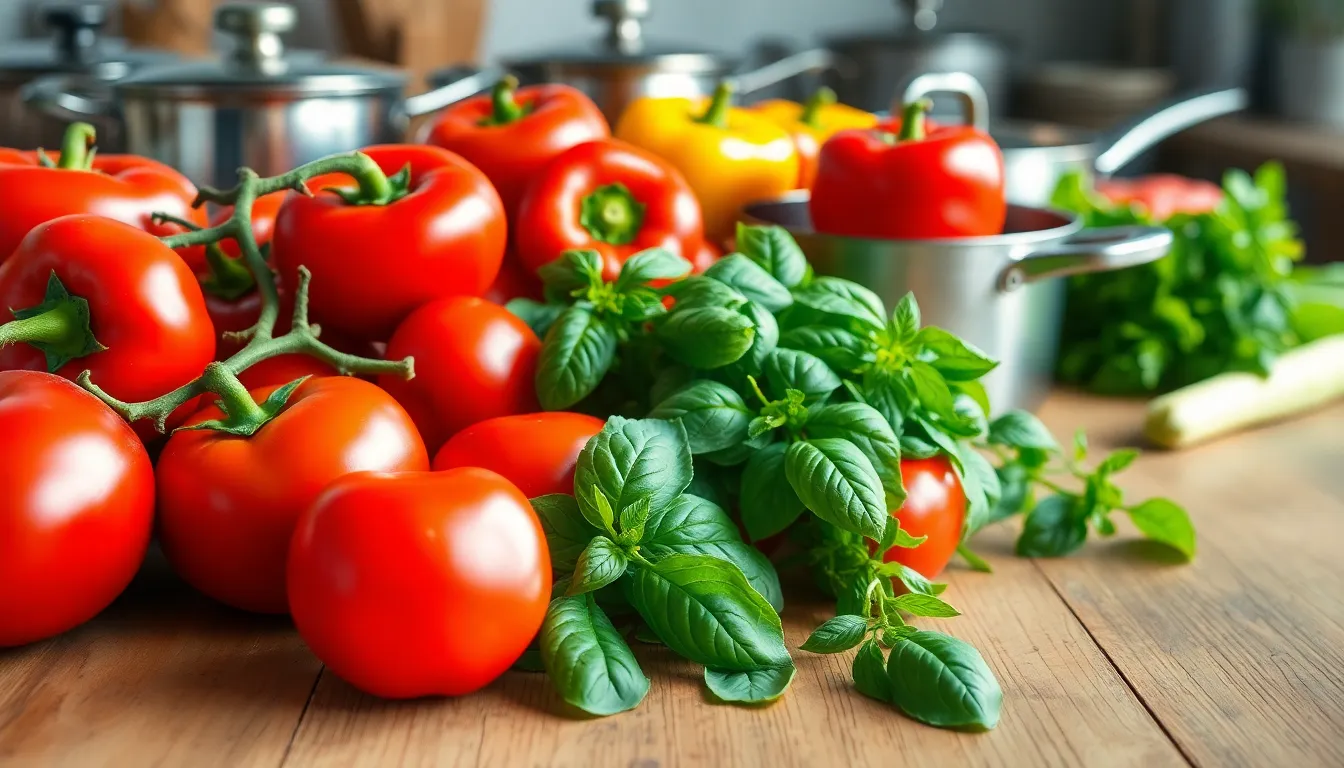Italian cooking isn’t just about tossing pasta into boiling water and hoping for the best. It’s an art form, a delicious dance of flavors and techniques that can turn a simple meal into a culinary masterpiece. From the delicate touch of a skilled hand to the robust flavors of fresh ingredients, Italian cooking techniques have captivated taste buds around the world.
Imagine sautéing garlic in olive oil, the aroma wafting through the air like a siren’s call. Each technique, whether it’s perfecting the al dente pasta or mastering the art of risotto, tells a story steeped in tradition and passion. So grab your apron and get ready to dive into the savory world of Italian cuisine, where every dish is a celebration and every bite is a reason to smile.
Table of Contents
ToggleItalian Cooking Techniques
Italian cooking techniques emphasize simplicity, showcasing the flavors of fresh ingredients. Sautéing plays a crucial role, especially with garlic and olive oil forming the foundation of many dishes. Boiling pasta to al dente is essential; this technique ensures a firm texture and flavorful bite.
Risotto requires patience and precision. Stirring frequently prevents sticking and allows for the gradual absorption of broth, resulting in a creamy consistency. Maintaining a consistent temperature is vital for achieving the perfect risotto.
Grilling adds a smoky depth to vegetables and meats. It enhances flavors while incorporating charred elements that evoke the essence of Italian outdoor dining. Braising combines moist and dry heat to tenderize tougher cuts of meat, allowing rich flavors to permeate.
Emulsifying sauces like pesto showcases the balance between oil and herbs. This process unifies ingredients, creating a vibrant, flavorful mix. Baking also holds significance, particularly in dishes like lasagna, where layers meld, yielding a comforting result.
Frying techniques, such as frying arancini or tempura vegetables, provide a crispy exterior while preserving the interior’s moisture. Using the right oil and temperature contributes to an ideal fried dish.
Steaming vegetables retains vibrant colors and nutrients, enhancing the overall healthiness of the meal. Seasoning with herbs and spices elevates dishes; choosing traditional Italian herbs like basil, oregano, and rosemary enhances authenticity.
Utilizing these fundamental techniques fosters a deeper appreciation for Italian cuisine, encouraging exploration and mastery in the kitchen. Embracing the methods brings the celebration of flavors in every dish.
Essential Cooking Methods

Italian cooking relies on various techniques that highlight the taste of fresh ingredients. Each method contributes to the overall experience and enjoyment of the dish.
Boiling and Blanching
Boiling serves as a fundamental technique in Italian cuisine. It’s commonly used for pasta. Optimal timing achieves the desired al dente texture. Blanching involves briefly immersing vegetables in boiling water. This method enhances colors and preserves nutrients. Following blanching, ice water stops the cooking process. Broccoli and green beans often get treated this way, maintaining their crunch. These techniques set the stage for vibrant, flavorful meals, allowing each ingredient to shine.
Sautéing and Stir-Frying
Sautéing forms the backbone of many Italian dishes. It often begins with garlic gently sizzling in olive oil. This technique builds a fragrant base that infuses flavor into the dish. Stir-frying also finds its place in Italian cooking, showcasing vegetables and proteins quickly cooked over high heat. Customary ingredients like bell peppers and zucchini benefit from this technique, offering a crisp bite. Mastery of sautéing enhances sauces, while stir-frying presents a dynamic way to prepare seasonal produce.
Baking and Roasting
Baking stands out in Italian cuisine, particularly in dishes like lasagna. This method melds flavors seamlessly and creates comforting textures. Roasting vegetables intensifies their natural sweetness, with options like eggplant and bell peppers shining through. Optimal temperatures ensure a caramelized exterior while maintaining tenderness inside. These techniques elevate the overall dining experience, making meals memorable. Both baking and roasting capture the essence of Italian culinary traditions, bringing warmth and depth to every dish.
Specialized Techniques
Italian cooking incorporates specialized techniques that enhance flavor and texture. Mastery of these methods showcases the cuisine’s depth and artistry.
Slow Cooking
Slow cooking generates rich flavors and tender textures by allowing ingredients to meld over time. This technique often involves using a low, consistent heat to break down tougher cuts of meat. For example, ossobuco braises veal shanks with vegetables and broth for hours, resulting in a melt-in-your-mouth experience. Classic dishes like ragù benefit from this method, as simmering allows spices and herbs to impart their essence. Additionally, slow-cooked beans absorb flavors, adding heartiness to meals.
Sous Vide
Sous vide offers precision and control over cooking temperatures. By sealing food in a vacuum bag and submerging it in a water bath, chefs maintain the integrity of ingredients. This technique allows proteins like chicken and fish to cook evenly without overcooking. For instance, a chicken breast cooked sous vide retains moisture and tenderness, offering a distinct texture. Many sauces infused with herbs contribute depth to the final dish, demonstrating the sophistication of Italian cuisine. Chefs also leverage sous vide for vegetables, preserving vibrant colors and nutrients while enhancing flavors.
Grilling
Grilling imparts a smoky flavor while caramelizing the natural sugars in ingredients. This technique transforms vegetables, meats, and even pizzas, lending distinctive charred textures. Popular grilled dishes include bruschetta, where bread toasts over an open flame, developing a crispy exterior. Meats such as chicken or lamb skewers absorb marinades, yielding savory results. In Italy, grilling isn’t limited to entrées; grilled fruits serve as delightful desserts, showcasing the versatility of this cooking approach. Mastering grilling enhances outdoor culinary experiences and brings a unique twist to Italian dishes.
Flavor Enhancements
Flavor plays a vital role in Italian cuisine, with marinades and seasonings elevating dishes to new heights.
Marinades and Seasonings
Marinades incorporate various ingredients, such as olive oil, vinegar, herbs, and spices. They tenderize meat while infusing flavors that enhance the overall dish. Garlic, rosemary, and oregano frequently appear in Italian recipes, often complementing grilled meats and roasted vegetables. Prioritizing fresh herbs adds vibrancy, providing bright notes that truly define the cuisine. Citrus juices, like lemon and orange, also impart acidity, balancing rich flavors. Using salt thoughtfully enhances essential tastes, creating depth without overpowering the ingredients. Experimenting with different combinations yields a wide range of mouthwatering effects, perfect for marinating chicken, fish, or vegetables.
Infusions and Reductions
Infusions create complex flavors through the slow extraction of aromas. Olive oil infused with garlic, herbs, or chili flakes transforms a simple condiment into a flavorful drizzle. Making reductions involves simmering sauces to concentrate flavors, thickening the consistency while enhancing the richness. Classic sauces, like marinara or demi-glace, benefit from this technique, which intensifies their savory notes. Combining ingredients like wine, stock, and fresh herbs in reductions brings a unique character to pasta dishes. Balancing flavors in reductions highlights the art of Italian cooking, showcasing the craftsmanship behind each dish.
Regional Variations in Techniques
Italian cooking varies significantly across regions, with each area showcasing distinct techniques shaped by local ingredients and traditions.
Northern Italy
In Northern Italy, cooking techniques focus on cream-based sauces and polenta instead of tomato-centric dishes. Risotto exemplifies the region’s dedication to texture, relying on Arborio rice cooked slowly for creaminess. Grilling meats, especially game, becomes a popular practice in the Alpine regions, enhancing flavors with smoke. Notably, white truffles and rich cheeses play essential roles, showcasing local biodiversity. In addition, braising meats like osso buco enriches dishes with depth, reflecting a preference for hearty flavors. The use of fresh herbs, particularly in pesto, highlights seasonal produce and elevates the overall taste profile.
Southern Italy
Southern Italy embraces vibrant flavors, emphasizing tomatoes, olive oil, and fresh vegetables. Techniques like sautéing and frying dominate, particularly in dishes like caponata and arancini, creating bold textures. Pasta-making remains integral, with shapes like orecchiette crafted by hand to highlight tradition. Curing meats, especially prosciutto and salami, showcases preservation methods essential for flavor. Additionally, seafood grilling highlights the coastal bounty while infusing dishes with a smoky richness. Traditional sauces like marinara reflect the simplicity and authenticity prized in this region, allowing the natural flavors to shine.
Italian cooking techniques offer a rich tapestry of flavors and traditions that invite exploration and mastery. Each method highlights the importance of fresh ingredients and the artistry involved in crafting authentic dishes. From the simplicity of sautéing to the patience required for risotto, these techniques transform meals into celebrations of taste.
Embracing these methods not only enhances culinary skills but also deepens appreciation for the diverse regional influences that shape Italian cuisine. Whether it’s the creamy textures of Northern Italy or the vibrant flavors of the South, each technique reveals the heart of Italian cooking. By integrating these practices into everyday cooking, anyone can bring a piece of Italy into their kitchen and delight in the joy of preparing and sharing meals.




